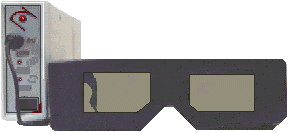
The unofficial EyeFX page
Quick info:
The EyeFX VRS by Tetratel
Corp. is a wired 3D-shutterglasses system for any hardware platform.
It features a VGA-pass-through controller which syncs to any (!) screen
mode. In addition it has a switchable "Line Blanker"
device which generates artificial interlace in conjunction with any (!)
graphics-board. No driver software required. The EyeFX is 100% compatible
to any computer and graphics hardware as long as a standard monitor (no
LCD) is used. Software compatibility includes all frame and line sequential
titles. The above-below split-screen format is NOT supported. The bundle
includes the full retail version of Z.A.R.
The EyeFX is similar in functionality
to the VR-Joy. Compared to the VR-Joy it has some minor advantages and
disadvantages. Read the EyeFX vs. VR-Joy shootout.
My verdict: The EyeFX and the competing
VR-Joy are the best consumer systems for general use I have tested so far
. They can't replace the H3D in the 3Dfx department though.
This review isn't
intended for beginners. Please consult the Basics
and FAQ pages if questions arise.
Related Links:
Tetratel
Corp.
VR-Joy review
EyeFX vs. VR-Joy
shootout
EyeFX and VR-Joy
game chart
Firedance review
Z.A.R. review
Madspace review
This page was innitially released on September 10, 1998,
last update: October 4, 1998


Test configuration:
Cyrix 6x86 PC
Windows 95b
Matrox Mystique 220
IDEK Iiyama Vision Master 17 monitor (86 kHz max. hor., 160 Hz max.
vert.)
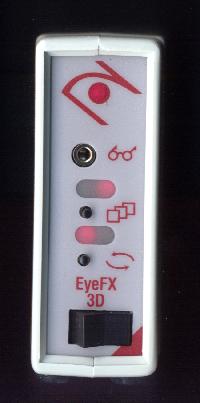
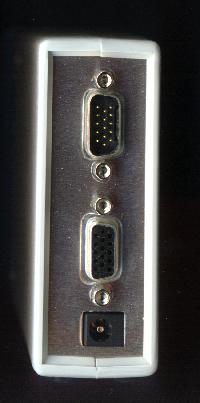
Front and back of the EyeFX VRS autosync
and line-blanker controller
The EyeFX controller is a VGA-pass-through device and behaves
exactly like my beloved homebrew VGA-PT circuit.
The controller just syncs to anything (page-flipping and interlace). In
addition it has a switch to activate "line-blanking" which provides
interlace in any case, even on VGA-boards which usually do not support
it. There is no sync-doubler functionality for the split-screen-format
though. The split-screen format is used in professional application and
H3D/Voodoo titles.
Instead of the usual VGA-pass-through dongle the EyeFX
controller has two standard VGA-connectors. A normal VGA-cable connects
the controller with the VGA-board. The monitor is then connected to the
box. Similar procedure as with a Voodoo board and yielding the same problems.
High resolution/high refresh modes, like my 1024x768@85 Hz windows desktop
are hurt by this solution. The usual small dongles, like the one of the
VR-Joy also have an impact on image quality, but not as severe. The EyeFX
causes strange ghosts, i.e. signal reflections. I replaced the long -90
cm- EyeFX VGA-cable with my short -25 cm- 3Dfx pass-through cable, which
didn't help much. The manual suggests to use a shielded cable for high
resolutions. Maybe a good cable with ferrit core will solve the problem.
At least the EyeFX system gives you the chance to choose your own cables,
while other systems leave you stucked with their proprietary dongle-cables.
On the other hand the signal has to pass the EyeFX controller printed circuit
in any case.
The controller looks like an external modem, and uses 5 LEDs to indicate
power-status, stereo-orientation and the 4 available 3D-modes. It looks
quite professional that way.
The 4 modes:
1) Autosync for interlace and page-flipping
2) Autosync for interlace and page-flipping alternate mode
3) one half of the lines blanked continuously, thus transforming 3D
into half-res 2D (an interesting and useful feature)
4) Line-Blanking
There's a power-button to switch off the glasses. Usually the
VGA-signal is passed-through while power is off, even if the power plug
is pulled on the EyeFX. On some hi-res and or hi-refresh modes the screen
went blank after shutting off the unit, at least on my monitor.
There are two control buttons, one for mode-select and one for
stereo-reverse, which are a bit small and pointed for controls which have
to be used that often. Yes they are used often, you will need them several
times during a single 3D-session.
The box has one standard 3.5 mm stereo jack (headphone format) for wired
shutterglasses. Using standard headphone adaptors two, maybe even more,
glasses should work. I tried the EyeFX and the 3D-Max-type glasses simultanously.
No problems here. The SPEX-type glasses could use a bit more voltage, but
they work fine on the EyeFX controller too.
Will it work for 3Dfx Voodoo Graphics and Voodoo 2 add-on boards?
Yes, but there's no software yet. The images would have to be in interleaved
line format. The split-screen format as it is used by H3D is NOT supported.
In theory it would be very easy for a programmer to modify such programs
to display interleaved format instead of split-screen.
On Voodoo Rush or Rendition boards H3D titles will work
right away with the EyeFX due to the hardware-page-flipping format. The
same may apply for the upcoming 3Dfx Banshee chipset.
Always check the stereo orientation by using
the reverse-switch at startup (and from time to time during a page-flipping
-i.e. LCD-BIOS- stereo-session). Using LCD-BIOS the stereo orientation
can change every second and render the software useless.
Beginners can easily miss the fact that the
image is reversed, which results in eye&brain-strain and an unsatisfying
3D-experience.
Power

The controller is powered by an external adaptor. Too bad they didn't
do the i-Art trick with the keyboard connector.
Input is 120V, output is: 6V, 200mA. There's no 220V version, right now,
but I had no problem get it working with my cheap - but "stabilized" -
universal power adaptor.
Documentation
Poor! Just a card with some basic instructions. No information on 3D-basics,
photography, programming, etc. No introduction to the technical principles:
interlace, page-flipping, line-blanking.
Like the H3D and the VR-Joy the EyeFX features circuitry
which I refer to as "Line Blanker". Like the VR-Joy and opposed to H3D
the control of the device lays in the hands of the user, which is GREAT
!!! No proprietary software required. Just a push of a button and you're
done.
The EyeFX Line-Blanker is quite flexible when it comes to resolutions
and refresh rates, but seems to have problems on very low refreshs. At
640x480@60Hz the stereo-orientation was very unstable, but such a low setting
isn't recommended anyway. At 70 Hz and up I saw no problems. High refresh
rates up 160 Hz also showed no problems. At hi-res/hi-refresh i.e. 1024x768@85
Hz I saw a larger artefact on one eye in one corner of the screen, but
this may be pass-through-cable related as discussed in the controller section
of this page.
The Line Blanker works on any software which provides an interleaved
line stereo-3D image format.

interleaved line stereo format
Usually driver software and a compatible VGA-chipset is required
to display such an image in a shutterglasses-compatible way.
With the Line Blanker you don't need any software or any special VGA-hardware.
What the line blanker does:
VGA card and monitor are in a normal mode. Resolution & refresh
are normal, but your eyes see interlace.
How is this done?
Here you go: The controller scans the frame and blanks out the odd lines.
In the next frame the controller blanks out the even lines
and so on. The refresh rate and other parameters aren't changed. The
lines are still there, they're just black now. This is not even
page-flipping. It's what I would call "synthetic interlace", without
the participation of VGA-card or monitor.
Graphics mode compatibility
I tested the EyeFX at resolutions from 320x200 to 1600x1200 at refresh
rates from 50 to 160 Hz.
It usually works O.K.
Drawbacks of the Line Blanker !!!
1) Possible inaccuracies in the blanking process might lead to additional
ghosting or other unwanted effects?!? There seem to be no major problems
with the EyeFX though.
2) The impact on the monitor frequency is 2 times as high as real
interlace, at the same resolution & refresh.
3) The image is darker than in real interlace.
4) The problem of the black interlace lines remains, line-doubled
page-flipping just looks better.
5) Refresh rate isn't changed. Setting has to be done manually
using 3rd party utilities, like Scitech Display Doctor.
Remember:
The EyeFX minus the Line-Blanker equals an autosync system similar
to APEC VR97, i-Art VirtualEyes or the homebrew VGA-PT. You know I like
these systems, so I like the EyeFX and VR-Joy even more.
The Line Blanker uses standard screen modes. It doesn't change the
refresh rate, like a real interlace driver (3D-BIOS, VR-BIOS, 3D-Win,
etc.).
In case you can get your hands on any real interlace
driver (like i-Art 3DWin, APEC VR(97)-Viewer, Stereographics
SG-Toggle, VRex VR-BIOS, VRex SSDI) which works for your particular
VGA-board you might use this instead of the Line-Blanker. Real interlace
provides higher refresh and puts less pressure on your monitor.
On the other hand: It's much more fun to just push the MODE-button
than to fiddle around with drivers. AND... most important: many of the
newest, hottest VGA-boards are not supported by current driver software
and never will be, because they don't do interlace anymore.
Some programs (games to be precise) require a 3D-driver like LCD-BIOS
or VR-BIOS.
When using LCD-BIOS or native SimulEyes titles with a VGA-pass-through
device like the EyeFX the usual drawbacks
(instable stereo orientation) apply.
When using the Line-Blanker use Scitech Display Doctor or a similar
tool to set a higher refresh rate!
The same applies in case the EyeFX is used with LCD-BIOS, NuvFrag
or native SimulEyes titles.
In case the EyeFX controller stops working at a certain refresh
rate use Display Doctor to change the sync polarity !!!
Unfortunately there are many programs using standard VGA modes instead
of VESA which might get you stuck at 70 Hz.
(Try the LCD-BIOS hi-refresh command line option in this case.)
Don't forget to deactivate the Line-Blanker when using a 3D-Driver or
a native SimulEyes or H3D title.
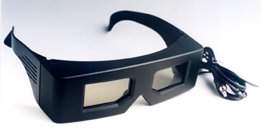
The EyeFX glasses are wired and weight 70 g.
They seem to be identical to the wired glasses APEC
uses. The glasses are large and should fit any head-size and any prescribed
glasses. The nose-piece isn't perfect, but since the glasses are light
it's not a major problem. Using them over prescribed glasses the nose-piece
might not even have contact with your nose. The LCD-panels are very
large: 4.3 * 2.5 cm. Good!
The cable length is 190 cm. That's more than enough since the
controller resides on the desk. The cable is thick and flexible.
Please check the X-RAY Lab for a weight&size
comparison of various shutterglasses.


Due to the Line-Blanker device the EyeFX is 100% compatible
to any computer system and any graphics hardware. It'll work with any standard
tube-monitor or -projector (not LCD!!!) which is connected via a standard
15-pin jack.
As far as I know the EyeFX is 100% hardware compatible
(not neccessarily software compatible, since some drivers are not available
for free) to the following shutterglasses systems and HMD's (apart from
the known drawbacks):
-
VR-Joy (of course)
-
3DTV 3D Magic
-
3DTV 3D PCTV (except for the TV functionality)
-
Nuvision 3D-SPEX
-
Cyberstuff Cyber3DVisor
-
Woobo Cyberboy
-
Chinon Cybershades
-
Stereographics SimulEyes
-
VRex VRSurfer
-
miro 3Dfanatix
-
APEC Virtual Visor
-
APEC VR97
-
i-glasses
-
CyberMaxx
-
homebrew controllers: serial, parallel, VGA-PT
The EyeFX is only partially compatible to the following devices
(depending on the VGA-chipset, 3D-driver and software used)
-
Kasan 3D-Max
-
H3D Eyewear
-
VFX-1
-
Canopus Total3D
The EyeFX is compatible to any software which delivers an interleaved
line or page-flipping format.
No driver required.
A standard web-browser or slideshow program is sufficient for viewing
stereo-images.
EyeFX will work for any operating system (Windows, DOS, Mac, Unix,
whatever).
Apart from that the EyeFX controller should work with the following
driver-software:
-
LCD-BIOS (apart from the known drawbacks)
-
Nuvision NuvFrag (apart from the known drawbacks)
-
Nuvision WinSPEX
-
i-Art 3DWin
-
APEC VR(97)-Viewer
-
Stereographics SG-Toggle
-
VRex VR-BIOS
-
VRex SSDI
-
VESA3
-
The EyeFX works also for programs which invoke interlace or page-flipping
by themselves, like SimulEyes titles or, in some cases, H3D-titles
All drivers are copyrighted. All drivers, except the VRex and i-Art drivers
are available on the internet. Click here for
driver-overview and -links. VRex SSDI will be available on the
net someday I hope.
Incompatibilities:
-
split-screen format isn't supported (like H3D titles on Voodoo Graphics
& Voodoo 2)
-
Kasan 3D-BIOS can be used with the VR Joy hardware, but the Kasan
3D-Max ISA card still has to be installed!
-
HMD software, especially titles for the VFX-1, might check for the presence
of the particular hardware
Visit the EyeFX game compatibility
chart.
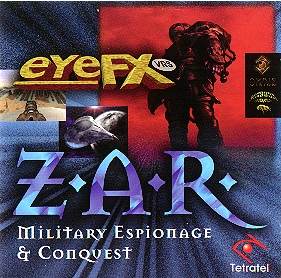
The EyeFX is bundled with the full
version of Z.A.R., a stereoscopic first-person shooter.
Check the Z.A.R. page.
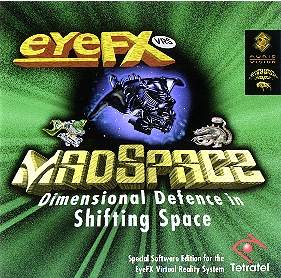
The EyeFX edition of Madspace another
first person shooter is available seperately.
Check the Madspace
page.
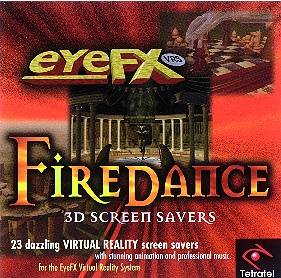
Firedance is a collection of excellent
stereo 3D animations with sound. It's available seperately.
Check the Firedance
review.
Special thanks to Tetratel
Corp. for providing me with a free EyeFX VRS sample.


|
Please consult the Shutterglasses
Comparison
Chart for a complete market-overview.
|
Brand and product names are trademarks or registered trademarks of their
respective holders.
The author can not guarantee the accuracy or topicality of the information
given on this page.
Christoph Bungert, Germany










